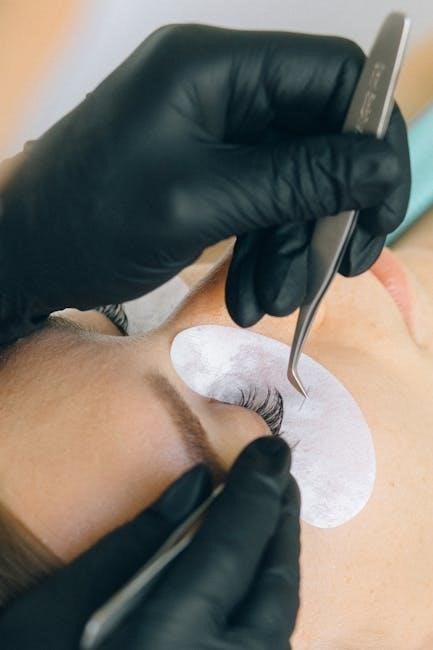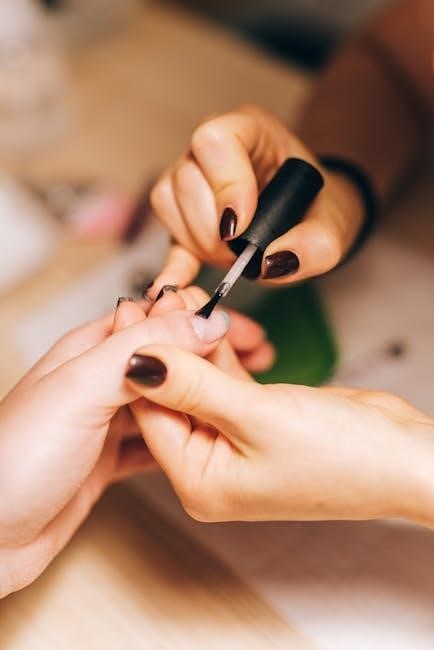Surface Preparation
Surface preparation is crucial for vinyl decal application. Ensure the area is clean‚ dry‚ and free of dust or oils. Use sandpaper to smooth rough surfaces and remove old decals for better adhesion.
1.1 Cleaning the Surface
Cleaning the surface is the first step in preparing for vinyl decal application. Start by removing dirt‚ grime‚ or grease using mild soap and warm water. Scrub the area gently with a soft sponge or cloth to avoid scratching. Rinse thoroughly with clean water to ensure no soap residue remains. For tougher stains or oils‚ use an alcohol-based cleaner‚ but avoid harsh chemicals that might damage the surface. Allow the surface to air dry completely or use a lint-free cloth to speed up the process. A clean‚ dry surface ensures proper adhesion and prevents bubbles or peeling. Avoid using paper towels‚ as they may leave lint behind.
1.2 Drying the Surface
Drying the surface is a critical step after cleaning to ensure proper vinyl adhesion. Allow the surface to air dry completely‚ as any moisture can interfere with the decal’s grip. For smoother surfaces‚ a lint-free cloth or microfiber towel can be used to gently pat dry‚ removing excess moisture without leaving streaks or lint. Avoid using heat tools like hair dryers‚ as they may damage certain materials or cause the surface to expand. Ensure the area is moisture-free and cool to the touch before proceeding. Proper drying ensures the vinyl adheres evenly and prevents peeling or bubbling. This step is especially important for surfaces exposed to humidity or recent cleaning.

Tools and Materials Needed
Essential tools include a squeegee‚ scissors‚ cutter‚ weeding tools‚ and transfer tape. These ensure accurate cutting‚ smooth application‚ and proper decal placement.
2.1 Essential Tools
For a successful vinyl decal application‚ gather essential tools to ensure precision and ease. A vinyl cutter or craft cutter is necessary for cutting designs. Use a squeegee to smooth out air bubbles and ensure proper adhesion. Weeding tools‚ such as a weeding hook or pick‚ help remove excess vinyl. Sharp scissors or a craft knife are handy for trimming. Transfer tape is crucial for transferring the decal to the surface. A ruler or measuring tape ensures accurate placement. Lastly‚ a clean‚ flat surface and a cutting mat are recommended for cutting and weeding. These tools are indispensable for achieving professional-looking results.
2.2 Optional Tools and Materials
While essential tools are required‚ optional tools can enhance your vinyl decal application process. A heat tool or hairdryer is useful for smoothing stubborn air bubbles or ensuring adhesion on curved surfaces. Infrared lamps can pre-heat decals for easier application. A laser cutter offers precision for intricate designs. Application fluid prevents bubbles during placement‚ while laminating pouches protect decals from wear. A cutting strip or grid mat helps align vinyl accurately. These optional tools and materials provide additional control and protection‚ making the process more efficient and the results more durable. They are especially beneficial for complex projects or long-term applications.

Cutting Your Vinyl Decal
Cutting your vinyl decal requires a vinyl cutter for precision or a craft knife for manual cuts. Ensure designs are mirrored and blade depth is set accurately for clean cuts.
3.1 Using a Vinyl Cutter
Using a vinyl cutter is the most efficient way to cut intricate designs. Start by importing your design into cutting software and ensure it’s mirrored if necessary. Load the vinyl‚ with the backing side up‚ into the cutter. Adjust the blade depth and pressure according to the vinyl type. Send the design to cut‚ monitoring the process to ensure clean lines. After cutting‚ inspect the vinyl for any uncut areas and use a weeding tool to remove excess material. For detailed cuts‚ a smaller blade may be necessary. Proper alignment and settings are key for accurate results. This method is ideal for complex designs and large-scale projects.
3.2 Cutting by Hand
Cutting vinyl decals by hand is ideal for small‚ simple designs. Use a sharp craft knife or scissors to carefully trace the outline of your design. Place the vinyl on a flat‚ stable surface and use a ruler or cutting mat for precision. Apply gentle to moderate pressure‚ ensuring smooth‚ steady cuts. For intricate details‚ use a smaller blade or a craft knife with interchangeable tips. Avoid applying too much pressure‚ which can cause the vinyl to tear. After cutting‚ inspect the edges for any rough spots and trim as needed. Hand-cutting is best suited for small-scale projects or when a vinyl cutter is unavailable. It requires patience and attention to detail for clean results.

Weeding the Vinyl
Weeding is essential for removing excess vinyl from your design. Use specialized tools like a weeding hook or tweezers to carefully pull away unwanted material‚ ensuring a clean finish.
4.1 What is Weeding?
Weeding is the process of removing excess vinyl from your design after cutting. It involves carefully pulling away unwanted material that isn’t part of the final design. This step ensures that only the desired elements of the decal remain intact. Weeding is essential for achieving a clean and professional finish. Using tools like a weeding hook or tweezers‚ you can precision-remove small details and intricate cuts. Proper weeding prevents unwanted vinyl from transferring during application‚ ensuring your design looks sharp and accurate. It’s a crucial step before applying transfer tape‚ as any leftover excess can ruin the final result. Regular practice improves efficiency and accuracy in this process.
4.2 Tools for Weeding
Essential tools for weeding include a weeding hook‚ tweezers‚ and a credit card or similar flat tool. The weeding hook is ideal for precision work‚ helping to remove small vinyl fragments. Tweezers are useful for intricate designs and tiny details. A credit card or flat tool can be used to scrape away larger areas of excess vinyl. Optional tools like a pick or scraper can also aid in removing stubborn material. These tools help ensure clean and accurate removal of unwanted vinyl‚ making the application process smoother. Proper use of these tools prevents damaging the decal and speeds up the weeding process.

Applying Transfer Tape
Apply transfer tape over the weeded vinyl‚ ensuring it is flat and smooth. Use a squeegee to press firmly‚ avoiding air bubbles for a secure bond.
5.1 How to Apply Transfer Tape
Applying transfer tape is a critical step in vinyl decal application. Start by cutting a piece of transfer tape slightly larger than your vinyl design. Place the tape over the weeded vinyl‚ aligning it carefully to ensure it covers the entire design. Use a squeegee or credit card to smooth the tape from the center outward‚ removing any air bubbles. This ensures a strong bond between the tape and vinyl. Once applied‚ the transfer tape acts as a carrier‚ holding the vinyl in place for application. Properly applied tape guarantees a smooth transfer to your desired surface‚ ensuring your decal adheres cleanly and evenly without wrinkles or bubbles.
5.2 Smoothing Out Air Bubbles
Air bubbles can form during transfer tape application‚ so it’s essential to smooth them out promptly. Use a squeegee or credit card to gently press the bubble from the edge toward the center‚ allowing air to escape. For stubborn bubbles‚ apply heat with a hairdryer or heat gun to soften the vinyl‚ then press firmly. Avoid using sharp objects that might damage the decal. If bubbles persist‚ carefully pierce the vinyl with a needle and smooth the area again. Patience and gentle pressure are key to achieving a bubble-free finish. Proper smoothing ensures the decal adheres evenly to the surface‚ maintaining its appearance and durability.

Using a Squeegee
Use a squeegee to apply firm‚ even pressure‚ ensuring the decal adheres smoothly. This tool helps remove air bubbles and excess moisture for a professional finish.
6.1 Proper Squeegee Technique
Proper squeegee technique is essential for a smooth vinyl decal application. Start by holding the squeegee at a 45-degree angle and apply firm‚ even pressure. Begin from the center of the decal and work your way outward‚ ensuring no air bubbles form. Use a sweeping motion to cover the entire surface‚ paying extra attention to edges and corners. For larger decals‚ flip the squeegee to its flat side for broader coverage. After applying‚ use the rounded edge to gently press out any remaining air bubbles. Repeat the process if necessary until the decal lies flat and bubble-free. Avoid using excessive force to prevent stretching or damaging the vinyl.
Heat Tools for Application
Heat tools‚ like heat guns or hairdryers‚ are used to soften vinyl for better adhesion. Apply low to medium heat to avoid damaging the material‚ ensuring proper adhesion on curved or textured surfaces. Move the heat source evenly to prevent overheating and bubbles‚ promoting a smooth application.
7.1 When to Use Heat
Heat tools are essential for vinyl decal application on curved‚ textured‚ or uneven surfaces. Use heat guns or hairdryers to soften the vinyl‚ ensuring it conforms smoothly to the surface. Apply low to medium heat to avoid damaging the material. Heat is particularly useful for large decals or intricate designs‚ as it enhances flexibility and adhesion. When using heat‚ move the tool evenly to prevent overheating‚ which can cause bubbles or discoloration. Avoid excessive heat‚ as it may degrade the vinyl or transfer tape. Always test a small area first to ensure the heat setting is appropriate for the specific vinyl type and surface. Proper heating ensures a professional-looking finish and long-lasting adhesion.

Common Mistakes to Avoid
Avoid air bubbles by applying even pressure. Ensure proper surface preparation and avoid stretching the vinyl. Use the right tools to prevent misalignment or damage.
8.1 Avoiding Air Bubbles
Air bubbles are a common issue when applying vinyl decals. They occur due to uneven pressure or trapped air during application. To prevent this‚ use a squeegee to apply consistent‚ firm pressure in one direction. Start from the center and work outward to ensure air escapes evenly. If bubbles appear‚ carefully prick them with a needle and smooth the area with your finger or a squeegee. Avoid stretching the vinyl‚ as this can create additional bubbles. For large decals‚ apply transfer tape slowly and check for bubbles immediately. Using heat tools can also help eliminate air pockets‚ ensuring a smooth‚ professional finish. Always inspect the decal after application to address any issues promptly.

Aftercare and Maintenance
Regular cleaning prevents dirt buildup. Use mild soap and water. Avoid abrasive materials. Protect from direct sunlight to prevent fading; Touch up minor damages promptly.
9.1 Caring for Applied Decals
Proper care ensures longevity of vinyl decals. Clean with mild soap and water‚ avoiding harsh chemicals. Avoid abrasive materials that may scratch the surface. For outdoor decals‚ protect from direct sunlight to prevent fading. Regularly inspect for signs of wear and address minor damages promptly. Avoid exposing decals to extreme temperatures or moisture. Use a soft cloth to wipe away dirt or debris. For decals on vehicles‚ avoid high-pressure washes. Touch up any peeling edges with a small amount of heat or adhesive. Proper maintenance will keep your decals looking vibrant and intact for years to come.

Troubleshooting
Common issues include air bubbles‚ peeling edges‚ or poor adhesion. Use heat tools to smooth bubbles‚ reapply edges with adhesive‚ and ensure surfaces are clean and dry.
10.1 Fixing Common Issues
Common issues during vinyl decal application include air bubbles‚ peeling edges‚ or poor adhesion. To fix air bubbles‚ use a heat gun or squeegee to gently smooth them out. For peeling edges‚ reapply pressure or use a small amount of adhesive. Ensure surfaces are clean‚ dry‚ and free of dust or oils‚ as contamination can cause adhesion failures. If the decal lifts during transfer‚ reposition it carefully and apply more transfer tape. For stubborn bubbles‚ poke them with a needle and smooth with a squeegee. Always verify the vinyl type suits the surface material. Allow the decal to cure for 24 hours before exposing it to water or heat. Proper tools‚ like heat guns or adhesive sprays‚ can help resolve most issues. Consult product guides for specific troubleshooting tips tailored to your vinyl type.

Application on Different Surfaces
Vinyl decals can be applied to various surfaces‚ including curved‚ textured‚ and uneven ones. Adjust techniques like stretching‚ pressure‚ or using heat to ensure proper adhesion and smooth results.
11.1 Curved Surfaces
Applying vinyl decals to curved surfaces requires precision and patience. Start by aligning the decal with the center of the curve and gently press it onto the surface. Use a soft squeegee or your fingers to smooth the vinyl‚ working from the center outward. For complex curves‚ consider cutting the decal into smaller sections and applying them individually. Heat can be used to stretch the vinyl slightly‚ but avoid overheating‚ as it may damage the material. Ensure the surface is clean and dry before application. After applying‚ inspect the decal for air bubbles or wrinkles and smooth them out with a squeegee or heat gun if necessary. This ensures a seamless and professional finish on curved surfaces.
11.2 Textured Surfaces
Applying vinyl decals to textured surfaces can be challenging due to the uneven finish. For best results‚ ensure the surface is clean and dry. Use a high-quality vinyl designed for textured surfaces‚ such as Heat Transfer Vinyl (HTV) or adhesive vinyl with strong tack. Apply the decal using heat from a heat gun or hair dryer to help the vinyl conform to the texture. Use a squeegee or similar tool to press the vinyl firmly into the grooves. Avoid stretching the vinyl excessively‚ as it may lift from the surface. For deep textures‚ multiple applications or specialized tools may be needed. Allow the vinyl to cool before handling to ensure proper adhesion. This method ensures a durable and visually appealing result on textured surfaces.
11.3 Uneven Surfaces
Applying vinyl decals to uneven surfaces requires careful preparation and technique. Start by cleaning the surface thoroughly to remove dirt‚ dust‚ or oils. For deeply uneven areas‚ consider smoothing the surface with sandpaper or a file to create a more even base. Use a high-tack transfer tape to help the vinyl adhere to irregular shapes. Apply the decal slowly‚ using a squeegee or credit card to press the vinyl firmly into recesses and crevices. Heat from a hair dryer or heat gun can help the vinyl conform to complex contours. Avoid stretching the vinyl excessively‚ as it may lift from the surface. For highly uneven surfaces‚ cut the decal into smaller sections for easier application. Ensure proper adhesion by applying even pressure and smoothing out air bubbles as you go.
